The Society was advised by Cadogan on 16th October 2019 that they do not intend any narrowing of the carriageway of Sloane Street north of Basil Street. This is very welcome, but it is not clear as yet whether they intend any narrowing of the carriageway of Sloane Street between Basil Street and Harriet Street. We have agreed to meet with Cadogan again so that this important matter may be further discussed.
On 24th April 2019 the Chairman of the Society, Dr. James Thompson, wrote to the Leader of RBKC, Cllr. Elizabeth Campbell, as follows:
Dear Elizabeth,
SLOANE STREET
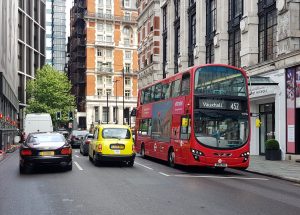
Our members are very concerned by the way in which the Council is dealing with the proposal to make changes to this important street, and in particular to make the road narrower at the north end of the street to accommodate parking bays for the shops..
We are not opposed to improvements in principle, and we have already indicated on the Society’s website https://chelseasociety.org.uk/sloane-street/ that we support the improvement of the pavements and the removal of unsightly telephone equipment, unnecessary signage, and other clutter. We also support additional trees and flower-beds subject to agreement on siting, appearance, and maintenance.
However, Sloane Street is a heritage street where change should be made only if a very strong case is made out, and we are opposed to the installation of raised tables at road junctions. No case for them has been made out on safety or any other grounds and it is necessary only to install drop-kerbs for wheelchairs and perambulators where they do not already exist. Having looked carefully on site at the traffic flows in both directions, we do not think that the carriageway should be made narrower at any point. This leaves scope for parking bays on the western side, where the pavement is very wide.
We are concerned that the Council has not responded to a single comment or criticism made by local residents, and still intends to restrict the width of the carriageway in the section of the street north of Harriet St., despite the damaging effect which this is likely to have on the free flow of buses and other traffic.
The report for Key Decision asserts that Sloane Street “is dominated by up to four lanes of traffic” and that “there is twice as much carriageway width than is needed to accommodate the volume of traffic using Sloane Street at peak times.” In fact in the northern section of the street there are only two lanes, with space for one bus in each direction. When, as is often the case, a bus is stationary and there is traffic in the other direction, a long queue forms rapidly. Making the road even narrower will compound the problem. I have myself attended a meeting with other officers of The Chelsea Society at this location where we met with representatives of the Council and others. We do not need to be told by traffic consultants what we can see with our own eyes every day.
The report claims that the proposals “received very positive responses from the community.” I find it strange that there could be very positive support from the community without The Chelsea Society being aware of it, and we do not believe that there is any such support. In fact the proposal to narrow the carriageway was opposed by all the relevant community organisations (the Chelsea Society, the Kensington Society, the Knightsbridge Association, the Brompton Association, and the local residents’ association (MISARA). There is no mention of this very significant opposition in the report, nor any attempt to address the points which these societies and associations have made.
It seems that the purpose of narrowing the carriageway north of Harriet St. is to provide parking for the customers of a few luxury shops, but we do not see how this commercial interest can prevail over the public interest in the free flow of buses and the avoidance of traffic congestion in this locality.
The Council’s claim that there is support for its plan seems to depend entirely on the responses to the questionnaire which was made available in January 2017. But this questionnaire was biased in that it invited respondents to tick a set of boxes indicating their priorities for Sloane Street. There was no box which identified traffic flow at the northern end as a priority. Respondents were able to express a preference between widening or not widening the carriageway in the central section of Sloane Street where congestion is not an issue, but not in the northern section where congestion is at its worst.
Elizabeth, we recall that you made a number of speeches, before and during the local elections, in which you acknowledged that the culture of the Council needed to change, and promised that that the Council would “take greater care to listen to residents’ views” and become “a truly listening borough” and that “we will be judged by what we do and not what we say”.
In the matter of Sloane Street however, the Council seems to have reverted to its pre-election behaviour. It organises a consultation designed to show support for a particular outcome, rather than to discover the residents’ views; it ignores those views when they are expressed; it pretends that support exists when it doesn’t; and it fails to engage with organisations which genuinely represent local people. It also seems to have been unduly influenced by a conditional offer of third-party funding. These are all matters which I am sure will be debated at the Society’s next AGM.
I am therefore asking you to review this Key Decision, and not to proceed with any narrowing of the carriageway of Sloane Street north of Harriet Street. If the choice is narrowing the carriageway or doing nothing we would prefer doing nothing.”
The Leader of the Council replied as follows:
The chairman of the Society responded to this reply as follows:
Cllr. Elizabeth Campbell,
Royal Borough of Kensington & Chelsea
Hornton St
London W8
27th June 2019
Dear Elizabeth,
SLOANE STREET
Thank you for your letter of 14th May, in response to ours of 24th April. However, I am afraid that the Society does not find your response at all satisfactory.
We think there are two main issues here:
1. PUBLIC SUPPORT
We think it is unacceptable for the Council to claim to have public support for the narrowing of the carriageway at the north end of Sloane Street.
(a) If there were any significant public support it would not have gone unnoticed by The Chelsea Society, The Kensington Society, The Brompton Association, The Knightsbridge Association, and MISARA. As you know, all of these representatives of local people were against that specific proposal.
(b) There is no mention of this opposition in the Key Decision report, nor any attempt to address the various points which these societies and associations have made.
(c) The Council’s claim that there is support seems to depend entirely on the responses to the questionnaire which was made available in January 2017. But this questionnaire was unreliable in that:
(i) It invited respondents to tick a set of boxes indicating their priorities for Sloane Street. But there was no box which identified the free flow of buses and the avoidance of traffic congestion as a priority;
(ii) Respondents were able to express a preference between widening or not widening the carriageway in the central section of Sloane Street where congestion is not an issue, but not in the northern section where congestion is at its worst.
We think that this is the most serious aspect of this matter as it shows that the Council (and indeed the Ward Councillors) are paying no attention and according no respect to the opinions of local people and their representatives on this specific issue, and are making an unjustified claim to have the support of local people for it.
2. NARROWING THE CARRIAGEWAY
(a) The issue is whether the widening of the footway at the north end of Sloane Street to accommodate the proposed parking bays would increase traffic congestion by narrowing the carriageway.
(b) We are not against luxury shops in Sloane Street, but in our view, there is no sufficient justification in the public interest for widening the footway to accommodate the proposed parking bays. Sloane Street is a major arterial route for buses and heavy construction traffic.
(c) Obstruction would be caused to southbound traffic by being unable to overtake a bus or other stationary vehicle as it presently can.
(d) It is true that northbound traffic is held up by traffic lights at Knightsbridge and Basil Street (as to which we have also made representations and attended meetings), but it would also be obstructed by southbound traffic trying to overtake a stationary vehicle on a narrower carriageway in Sloane Street.
(e) Traffic in each direction would be obliged to queue in single file, adding further to journey times and to diesel/petrol pollution (negating one of the Council’s, and the Mayor’s, objectives, to improve local air quality). Far from making the pedestrian experience more friendly, it would have the opposite effect.
(f) We do not think that enforcement of parking and waiting restrictions would solve the problem (even if we were confident that the Council would do this effectively), as the carriageway would simply be too narrow.
(g) Weight should have been attached to the views of The Chelsea Society, and the other representatives of local people, on whether the carriageway should be narrowed at all, and in our view an offer to involve the Society in discussing the details again is of little or no value.
The Chelsea Society is therefore asking the Council not to proceed with the narrowing of the carriageway at the North end of Sloane Street, and is giving notice that it would oppose any application for a Stopping-up Order.
Yours sincerely,
Dr. James Thompson
Chairman
Cc Cllrs. Weale, McVeigh, Idris, and Thalassites
*********************************
On 15th June 2016 the Chairman of the Society’s Planning Committee was invited by Cadogan to discuss their ideas for improving the streetscape of Sloane Street, and on 14th July he walked the whole length of the street with Cadogan’s Chief Executive, Hugh Seaborn. There was a public exhibition at 135 Sloane Street during the period 6-9 July, and RBKC issued a “Newsletter” giving an outline of their ideas.
However, the proposals do not mention the issue which causes most concern to local people, namely the traffic jams at the northern end of the street where it joins Knightsbridge. All too often the northbound traffic tails back as far as Hans Crescent and even beyond, and it is much quicker to walk than to stay on the bus.
On Tuesday 11th April 2017 a meeting was held in Sloane Street between The Chairman of the Society, the Chairman of the Planning Committee of the Society, the member for Hans-Brompton Ward on the Planning Committee of the Society; the Cabinet Member for Transport and the Chief Transport Engineer of RBKC; two traffic engineers from TfL; the Chief Executive of Cadogan, and a traffic consultant engaged by Cadogan.
When we were standing on the corner of Basil St at about 4pm the northbound traffic tailed back down Sloane St. as far as we could see – to Pont St and beyond. Clearly this is not acceptable, as Sloane St. is a major bus route. We were glad to have the opportunity to meet the two traffic engineers from TfL and to draw their attention to this specific problem.
The engineers confirmed that they give priority to East-West traffic at the junction with Knightsbridge, but they undertook to consider ways in which the problem could be alleviated. They will consider the phasing of the traffic lights, and the layout of the junction, and will also consider (in consultation with RBKC) our proposal that Basil St should be made one-way westbound. They also assured us that the junction is under observation from their control room at all times and that their controller will alert the police or traffic wardens immediately if they see any vehicle causing an obstruction.
In relation to Basil St., we noticed during the meeting a large number of vehicles exiting Basil St. and occupying spaces in front of the traffic lights which would otherwise have been available for northbound traffic in Sloane St. We accept that any change would have effects over a wide area and that those effects need to be carefully considered. We understand that traffic consultants engaged by Cadogan have considered this, and we have asked for a copy of their report, which has not been received.
Our main point of disagreement with the current proposals is the idea that the pavement should be widened on the east side of Sloane Street, between Harriet Street and Knightsbridge to provide parking spaces for the luxury shops in that location. This would narrow the carriageway at the north end of Sloane Street, which is very often heavily congested with traffic. It is obvious to us when standing in that location that narrowing the carriageway would make matters worse, and we do not need traffic consultants to tell us what we can see with our own eyes.
Nor do we see any justification in the public interest for taking away a stretch of carriageway for this purpose. If the customers for these shops arrive by car, as most of them do, it is usually a chauffeur-driven car which has no need to wait outside while the customer is in the shop. The chauffeur can easily be summoned by mobile phone when the customer is ready to leave.
There may be some public support for some of the proposals relating to other parts of Sloane Street, but we are not aware of any public support for narrowing the carriageway to provide parking for shops at the north end of the street. If there were any significant support we think it likely that The Chelsea Society and MISARA would be aware of it. We agree with the reasons given by MISARA as to why the public consultation cannot be relied upon on this point.
We have written to Cllr. Pascall, Lead-member for Highways about this and have also met with him. The Chelsea Society has also asked the three Councillors for Brompton-Hans Ward not to support the narrowing of Sloane Street at its northern end.
The Chelsea Society believes that RBKC, TfL and Cadogan should work together to alleviate the problem of congestion at the north end of Sloane St. by removing the traffic lights at the junction with Basil Street and making Basil Street one-way westbound. Southbound traffic on Sloane Street would be prohibited from turning right into Basil Street. In addition, Sloane Street together with its pavements may be wide enough on the western side between Basil Street and Knightsbridge to accommodate an extra northbound lane for traffic turning into Brompton Road, and a left-turn filter could be added to the traffic lights at that junction.
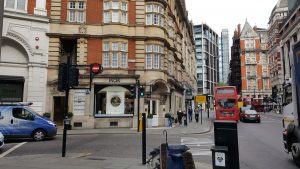
Perhaps the opening of this dialogue about Sloane Street will lead to something being done about this long-standing problem.
THE STREET HAS THREE SECTIONS
In relation to the proposals outlined in the RBKC Newsletter the street is divided into three sections
1. Commercial section in the North
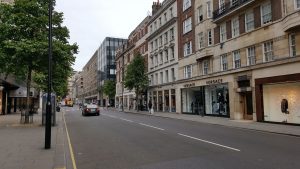
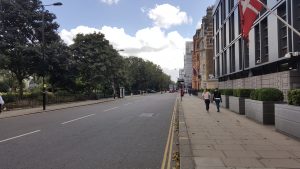 2. Residential and garden section in the centre, and
2. Residential and garden section in the centre, and
3 Commercial section in the South.
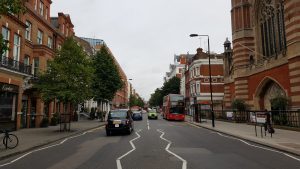
The starting point for policy is in our view the Hans Town Conservation Area Proposals Statement (January 2000) which states at page 46 “Sloane Square branches off southwards from Knightsbridge in a long uninterrupted vista line towards Sloane Square. The most characteristic visual element of the street is the long expanse of the mature gardens of Cadogan Place on its east side. In addition, the sense of openness of the street is established by the generous pavement and road widths.”
WIDTH OF PAVEMENTS
The existing pavements are wide enough for the pedestrian traffic. Pedestrian traffic in the central section is very limited because there are no shops in this section and there are buildings on the west side only. Most people travel from the northern section to the southern section and vice versa by bus, car or taxi.
We have heard no complaints that people find it difficult to cross the road. There is a long view in each direction and there are pedestrian crossings at the north and south end of the central section. Two small pedestrian refuges could however usefully be installed in this section of the street.
Another argument made for narrowing the road in the central section is to reduce the speed of traffic, but not many people wish to cross the road in the central section, and we do not see excessive speed as a problem on Sloane Street. We are not aware of any accidents caused by excessive speed. There are some types of car and motorcycle which attract attention by making a lot of noise without going very fast, and the police are taking action in this vicinity against irresponsible drivers.
During the day vehicles are often parked on the single yellow lines on both sides of the street for short periods notwithstanding the prohibition. Narrowing the road at this point would restrict the flow of traffic and cause increased journey-times and more air pollution. Currently visitors park there out of controlled-hours without obstructing traffic-flows. We do not see this as a problem, but if the road were narrowed it would cause obstruction.
We are opposed to the installation of raised tables at road junctions, and no case for them has been made out on safety grounds. This is a heritage street, and it is necessary only to install drop-kerbs for wheelchairs and perambulators where they do not already exist.
There is no significant incidence of accidents at these junctions involving pedestrians.
PARKING BAYS
We are not opposed to these in principle, but having looked carefully on site at the traffic flows in both directions, we do not think that the carriageway should be made any narrower. This leaves scope however for parking bays in places where the pavement is very wide.
APPEARANCE OF PAVEMENTS
The pavements are important features of the street, and we agree that they are looking shabby owing to lack of maintenance. They could be re-paved, preferably with York Stone, and where particularly wide, the expanse could be broken up with paving of a different colour or pattern. We would wish to be consulted before the colour and pattern were chosen and would not wish to see extravagant patterns such as in Exhibition Road.
In the wider sections of pavement flower beds and seating could be provided but we would wish to be consulted on the colour and design.
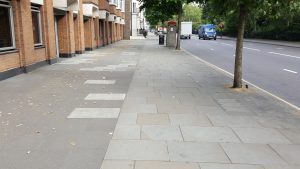
If flower beds are provided it is essential that they are properly tended and that Cadogan accepts permanent responsibility for this, as poorly maintained planting is unsightly.
There is a visible linear distinction between parts of the pavement in public and private ownership, but these need to be permanently maintained as an integral unit by agreement between the landowners and RBKC. Regular maintenance is again important.
STREET FURNITURE
There are a number of modern telephone kiosks in the street, which are of an unattractive design and are badly maintained. They are no longer essential in the age of the mobile phone, and should be removed, or replaced with traditional boxes of Gilbert Scott design.
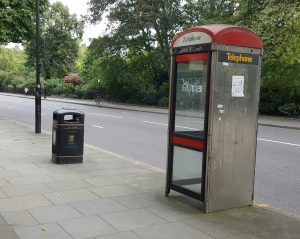
The existing heritage bollards should be reinstated into a vertical position and repainted.
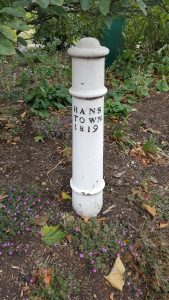
Telephone kiosks and telephone junction cabinets, litter bins, a bicycle rack and a grit box have been sited at random without any thought to their appearance or the convenience of pedestrians and they need to be re-sited, or removed if redundant.
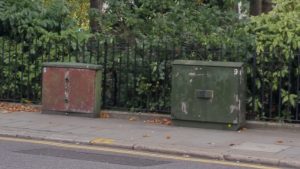
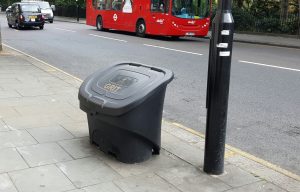
Essential traffic signs could be attached to a convenient lamp or traffic-light post instead of having their own post adding clutter to the pavement.
There are some maps on posts which are useful, but they should be sited on the bus stops. There are two very large and ugly black boxes on the pavement outside George House in the southern section, and these should be relocated.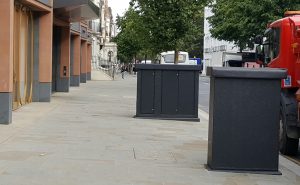

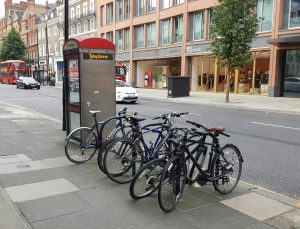
The street lighting is of functional modern design and provides adequate light. It is not essential to make any change – particularly at public expense, but if any changes were to be made it would be useful to see a range of alternative designs from which could be chosen lamp installations which are more in keeping with the traditional appearance of the street, whilst providing the required amount of light. They should continue to be black.
TREES
The Hans Town Conservation Area Proposals Statement mentions that “Sympathetic tree planting is effective in nullifying the overpowering effect of the imposing buildings which line the thoroughfare and help minimise the disruptive effect of the incessant through traffic.” There are many attractive trees in the street, but there are some gaps which could be filled with suitable trees provided they do not significantly obstruct the light to nearby premises.
There are some trees in the northern section which could be moved or replaced if they are causing obstruction. It would not be suitable to have flower beds around the trees, and protective fencing around trees should be removed, except for trees not yet established.
.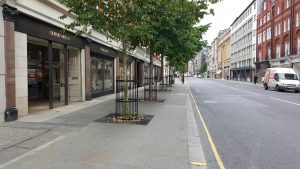
CONCLUSION
The Chelsea Society welcomes this consultation and looks forward to future dialogue with Cadogan, RBKC, and TfL. To the extent that public money would be expended we would wish to see the costings in order to form a view on whether the expenditure would be justified.
Michael Stephen
Planning Committee Chairman
[Last updated 14.4.17]



